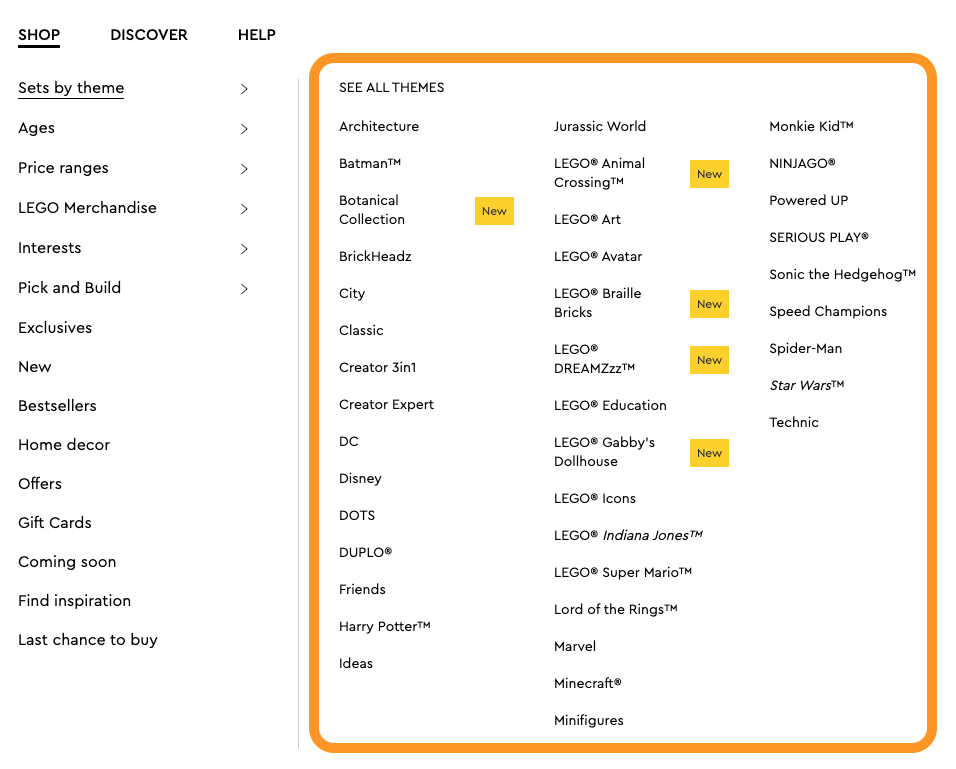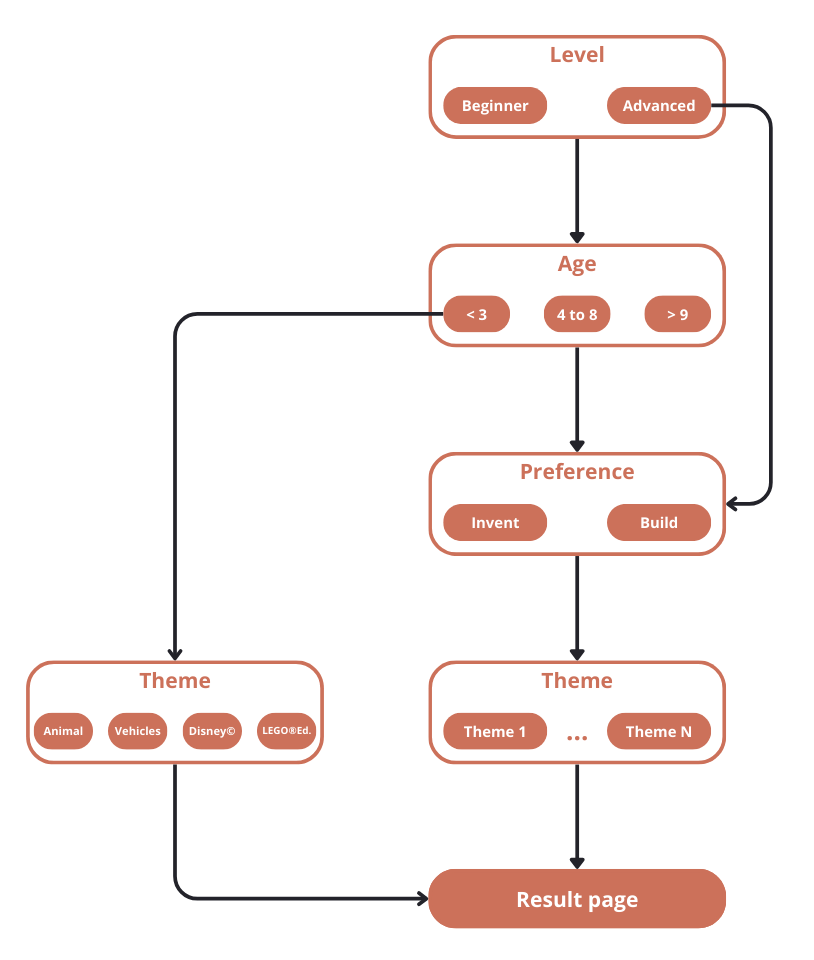Table of content:
Welcome back to the 2nd episode of our LEGO® Holiday Gifts Finder case study.
We’ll share how we enhanced this finder using Samareo Shopping Guide.
1. Product Catalog
As we delved into the vast LEGO® catalog, we discovered key characteristics—let’s call them dimensions—that will be the building blocks for our enhanced Shopping Guide.
 Reminder: while crafting each step and option, matching them with specific products, let’s always keep in mind the customer’s needs. Recognizing why a particular product suits certain customers and specific needs is important. Embracing this mindset will be instrumental in shaping each step and its options to perfection.
Reminder: while crafting each step and option, matching them with specific products, let’s always keep in mind the customer’s needs. Recognizing why a particular product suits certain customers and specific needs is important. Embracing this mindset will be instrumental in shaping each step and its options to perfection.
Disclaimer: Images and product catalog used for this Shopping Guide are sourced from the LEGO® website. Data may not be up-to-date as it is from early January 2024.
We apologize if Shopping Guide demo below leads you to an unavailable product.
2. Dimensions
2.1. Dimension #1: User’s Builder Experience Level
Let’s revisit one of the steps Holiday Gifts Finder and reframe it:
- Who is it for?
- Beginner builder
- Advanced builder
As highlighted in our 1st episode, beginners tend to find joy in smaller sets, defined here as products containing fewer than 500 pieces. This filter will be applied when users select “Beginner builder”. Conversely, for the “Advanced Builder”, the appreciation leans towards products with more than 500 pieces. While 500 pieces might sound like a substantial number, seasoned #FOL (Fan of LEGO®) know it’s just the beginning of an exciting build.

2.2. Dimension #2: User’s Age
While exploring the catalog, we noticed that age ranges are consistently specified in the product description page (PDP) and search filters. This naturally lends itself to being an essential criterion for our Shopping Guide, aligning users’ characteristics with product specifications.
- How old are they?
- Less than 3
- 4 to 8
- 9 and more
Knowing the user’s age is essential since LEGO® products are designed with specific age ranges in mind. It’s not just about suitability; it’s also about safety.

For users under 3, it’s particularly important to check for warnings regarding choking hazards, as specified in the PDP.

2.3. Dimension #3: User’s Preference
In our analysis, we’ve observed that some LEGO® sets are crafted for building and display, serving as eye-catching decorations on shelves. On the flip side, others are designed for immersive play, inspiring the creation of imaginative stories.
When it comes to user preferences, we want to know how they engage with their LEGO® experience:
- They prefer to…
- invent stories
- build with instructions
To map these preferences with the product catalog, selecting “Invent Stories” will lead us to products containing figurines and characters, easily identified through a simple search in the product descriptions. For the second option, we’ll ensure the selected products come with detailed building instructions.
2.4. Dimension #4: LEGO® Themes
LEGO® has excelled in creating diverse universes and themes, catering to an array of interests—from iconic franchises like Star Wars® to beloved characters like Super Mario™, the options are endless.

To enhance the guided shopping experience, our Shopping Guide features a powerful tool known as Dynamic Options. This feature allows us to dynamically generate selections, ensuring that customers are presented with only relevant options based on their previous selections. This thoughtful approach prevents the frustration of encountering empty result pages.
- What do they like?
- Dynamic themes based on user’s previously selected options
- Dynamic themes based on user’s previously selected options

2.5. Dimension #4: Variation
We recognize that the interests of users under 3 may differ from older ones. Hence, we’ve tailored a separate step specifically for this age group:
- What do you think they’d like?
- Animals
- Vehicles
- Disney
- LEGO® Education
3. Shopping Guide Overview
Take a bird’s-eye view of our Shopping Guide, outlining the steps, options, and paths customers will encounter.

You may have noticed that for customers selecting “Advanced builder,” we skip directly to the “Preference” step. We believe that for advanced builders, age is not as relevant, thus eliminating the need to consider it.
Additionally, for users under the age of 3, we’ve tailored a unique path. We bypass the “Preference” step and offer distinct options for their interests. At this young age, we find it unnecessary to select among different themes and brands.
4. Result Page Analysis
In continuation of our result page analysis from episode #1, let’s explore how the enhanced Shopping Guide performs.
Taking into account all possible paths, here’s the breakdown.
| Path | Total Results |
| Level:Beginner | Age:<3 | Interest:Animals | 17 |
| Level:Beginner | Age:<3 | Interest:Vehicles | 18 |
| Level:Beginner | Age:<3 | Interest:Disney | 3 |
| Level:Beginner | Age:<3 | Interest:LEGO® Education | 7 |
| Level:Beginner | Age:4 to 8 | Preference:Invent | Interest: N | 1 to 49 |
| Level:Beginner | Age:4 to 8 | Preference:Build | Interest: N | 1 to 51 |
| Level:Beginner | Age:>9 | Preference:Invent | Interest: N | 1 to 11 |
| Level:Beginner | Age:>9 | Preference:Build | Interest: N | 1 to 14 |
| Level:Advanced | Preference:Invent | Interest: N | 1 to 21 |
| Level:Advanced | Preference:Build | Interest: N | 1 to 25 |
Please note that for the “Interest” step’s Dynamic Options, we only display a range since there are 71 options, which could make the table unnecessarily long.
As illustrated, with a well-designed guide, offering relevant steps and options mapped efficiently to matching products, we significantly reduce customer choices. #LessIsMore. This not only prevents choice overload but also ensures the product selection perfectly aligns with customer’s needs.
5. Demo
5.1. Frontend Demo
Explore the frontend demo of our enhanced Holiday Gifts Finder.
Go ahead! Click on one of the options below:
Notice how smoothly it integrates into our WordPress website? Our Shopping Guide solution is frontend-agnostic and can be integrated into any platform containing HTML/CSS and JS.
5.2. Backend Demo
Curious to explore the backend screens of our Shopping Guide? Reach out via the contact us form, and we’ll be thrilled to provide you your access.
LEGO® is a trademark of the LEGO Group of companies which does not sponsor, authorize or endorse this page.
Star Wars® is a trademark of Lucasfilm Ltd which does not sponsor, authorize or endorse this page.
Super Mario™ is a trademark of Nintendo which does not sponsor, authorize or endorse this page.

